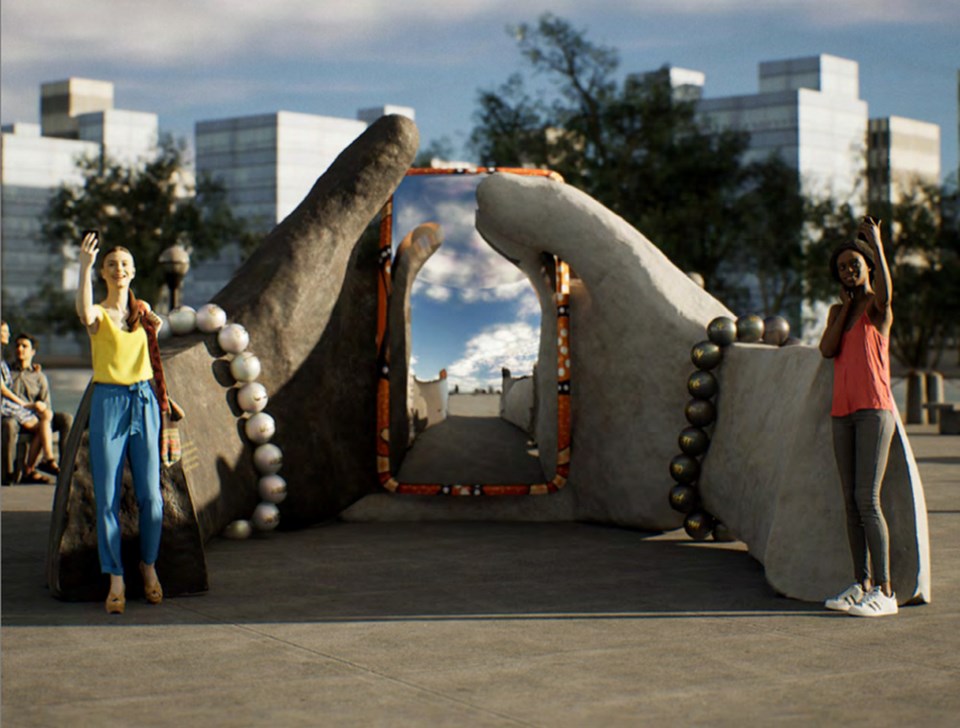A giant pair of concrete hands — one black, one white — clasping a mirrored cellphone could become a tourist attraction for Port Moody as self portraits with the sculpture are shared around the internet.
One of the artists involved with the project also hopes it will spark conversations about racism.
But whether the 3.7 m long by 2 m high work finds a home in the city, or where it might be situated will be discussed at a future meeting of council.
Tuesday, council’s committee of the whole voted to forward the public art proposal by Vancouver-based filmmaker Mostafa Keshvari and sculptor Parvenah Roudgar on to one of its regular meetings for further consideration.
Keshvari, whose film projects often explore social themes and issues like climate change, told councillors he wants to create something that invites more interaction and provides people an opportunity to reflect on a message of anti-racism. Working with Roudgar, whose outdoor sculptures are permanently placed in cities around the world — including one called “Mother and Child on a Bike” at the Inlet SkyTrain station — they devised the giant hands.
The outsized mirrored cellphone they’re grasping, he said, reflects society’s obsession with social media while also inviting people to see their own reaction to the artwork.
“As people take a picture of the sculpture, the sculpture also takes a picture of them,” Keshvari said.
The bi-racial nature of the hands, as well as beaded metal bracelets around each wrist, with the word “Unity” engraved in several languages on each bead, sends a message of racial harmony, he added.
“We are all in this together, we are all part of the same family.”
Keshvari said he’s working with local restaurateur Fred Soofi to secure funding to build the sculpture at no expense to the city. He just needs a place to put it.
And while he said he’s had preliminary discussions with the City of Vancouver, he’d like to see it in Port Moody as he’s moving to the city in November and it could further solidify its reputation as the “City of the Arts” to a broader audience.
“There’s a lot of abstract art in Port Moody, but we need something that is more relevant to current issues,” he said. “We need to create some sort of tourism as well.”
Coun. Zoe Royer, who’s also chair of Port Moody’s arts committee, said she’d love to see the sculpture located in Rocky Point Park, where visitors to the popular waterfront destination are sure to gather around and interact with it.
“It will stop people in their tracks,” she said. “It will be captured on many platforms and people will be talking about the conversations we want them to have.”
Coun. Amy Lubik suggested the placement of the sculpture somewhere along historic Clarke Street or at the Queen Street plaza would help bring people to those parts of the city.
But Coun. Hunter Madsen, who put forth the motion to bring Keshvari’s proposal to a future council meeting, wondered whether a sculpture goes far enough to address an important issue like racism.
“I’m not convinced doing this symbolic gesture would actually make our community less racist,” he said. “It lets us posture that we’ve figured it out.”
Madsen said any city funds used to install the sculpture might be better spent bringing in speakers and thought leaders, or creating projects with local First Nations.
Keshvari said he envisions the back of the mirrored cellphone being decorated by a First Nations artist and the sculpture could reach far more people than a series of talks or workshops.
“Art speaks louder,” he said. “Sometimes through art we find ourselves. We can create something that allows people to come to their own conclusions.”



